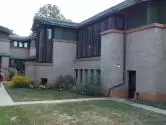Susan Lawrence Dana and Her Famous House

When in a former life I lived in Illinois, I had not yet discovered Arts and Crafts, and so, as a young enthusiastic English teacher, I explored those haunts you would expect a young enthusiastic English teacher to explore: the small town graveyard of Edgar Lee Master’s “Spoon River Anthology;” Huck Finn’s Hannibal; Tennessee William’s tenement houses of St. Louis; and Carl Sandburg’s boyhood home in Galesburg.
By the time I added a long list of Arts and Crafts meccas to my itineraries, I was living 663 miles away from Springfield, Illinois, and one of Frank Lloyd Wright’s most important, most well preserved Prairie School homes: the Susan Lawrence Dana House.
Completed in 1904, this 12,500 square foot masterpiece contained more than 100 pieces of Arts and Crafts furniture, 250 leaded glass doors and windows, and 100 art glass fixtures — each designed by Frank Lloyd Wright and executed under the supervision of George Niedecken, who also painted an original mural wrapping around the three walls of the vaulted dining room.
And so it was that last week I elected to drive back to Illinois for our annual Johnson family reunion so that I could spend a cool, delightful summer’s day in Springfield exploring the maize of rooms the 37-year-old architect from Oak Park had assembled for the most eccentric client of his blossoming career.

Born to wealthy, self-made parents, at age 21 Susan Lawrence married Edwin Dana, a promising entrepreneur. But the failure of Edwin’s real estate business and the deaths of their two infant children drove them back in desperation to her parents’ home in Springfield, where there was ample money to support them while they recovered. In 1900, however, 36-year-old Edwin was killed in an accident while inspecting a copper mine in Oregon. Six months later Susan’s beloved father died, placing his only daughter in charge of his $3 million estate.
By 1902 the young widow had met Wright, who agreed to transform her father’s towering 1868 Italianate residence into a low, unconventional Prairie School home, preserving part the original house in honor of her father. This unusual request was accompanied by an even more unusual announcement, one Wright loved to hear: Money was no obstacle.
In typical Wright fashion, once he had created the plan for the house and designed all of the furniture and fixtures for it, he turned the supervision of the construction over to a Springfield architect-contractor and the furnishings over to George Niedecken. Wright only visited the site a few times, generally taking the train back to Chicago on the same day. He and his first wife Catherine did attend one of the many house-warming parties hosted by Susan Lawrence Dana in 1904.
It would require the space of two books to describe the Lawrence Dana House and Susan Lawrence Dana herself: Eccentric. Spiritualist. Socialite. Philanthropist. Traveler. Hostess. Volunteer. Activist. Suffragette. She remarried in 1912 at age 49 to a handsome but poor Danish singer who was just 26. Tragically, he died just a year later from liver failure brought on by Bright’s disease. She rebounded, marrying a childhood friend in 1915, one who was a year older than Susan. They separated in 1920, however, and were divorced ten years later. So much for her choice of men.
Sadly, Susan’s life spiraled out of control, leaving her deeply in debt in her later years. She suffered financial, physical and emotional breakdowns, all of which contributed to the gradual deterioration of her beloved home. She was eventually ruled incompetent to govern her own affairs and taken from her home. In July of 1943, a six-day auction was required to dispose of her personal affects. She died in 1946 at the age of 83 with no family or friends at her side.
In 1944 the Thomas Publishing Company purchased the Lawrence Dana House for its offices, while maintaining the integrity of the building and its remaining contents. In 1981 the State of Illinois purchased what was then called the Dana-Thomas House for $1 million, and put another $5 million into its restoration, reopening it in 1990.
My experience at the Lawrence Dana House reinforced a lesson I had learned long ago: that despite how magnificent any home, any piece of furniture, art pottery, metalwork, or artwork might be, if we dig just a little deeper, we will find that the people behind its creation are even more interesting than the piece itself.

Until next Monday,
Have a great week!
Bruce
Photo credit for Susan Lawrence Dana: www.capitalcitiesusa.com
Top Photo: The walled courtyard of the Lawrence Dana House.
